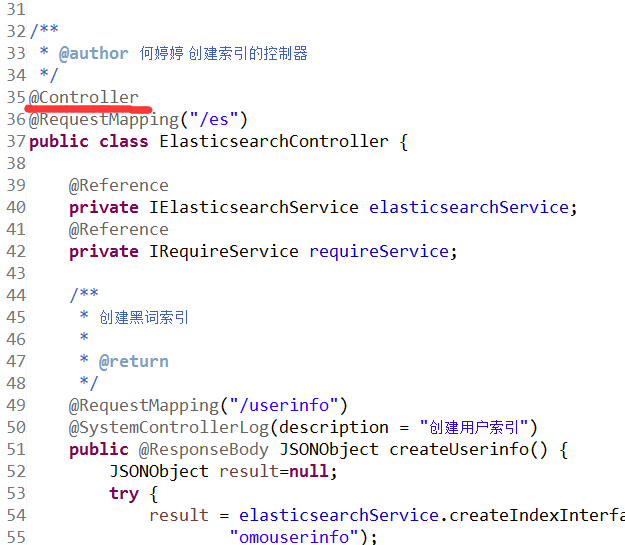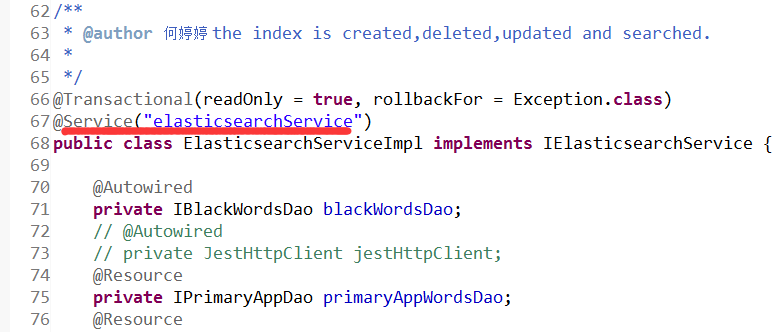spring中的注解都必须在配置文件中进行如下的配置:
<context:component-scan base-package="com.shanjin.oxm.service.impl,com.shanjin.oxm,com.shanjin.interceptorh,com.shanjin.oxm.service" />
1、@Component
@Component
是所有受Spring 管理组件的通用形式,@Component注解可以放在类的头上,@Component不推荐使用。
2、@Controller
@Controller对应表现层的Bean,也就是Action,例如:

3、@ Service
@Service对应的是业务层Bean,例如:

@Service("elasticsearchService")注解是告诉Spring,当Spring要创建elasticsearchServiceImpl的的实例时,bean的名字必须叫做"elasticsearchService",这样当Action需要使用elasticsearchServiceImpl的的实例时,就可以由Spring创建好的"elasticsearchService",然后注入给Action:在Action只需要声明一个名字叫“elasticsearchService”的变量来接收由Spring注入的"elasticsearchServicee"即可
4、@ Repository
@Repository对应数据访问层Bean
/**
* @author 何婷婷
*
*/
@Repository("requireDao")
public interface RequireDao {
/**
* 获取索引文档的信息
* @return
*/
public List<Require> getAllNeed();
/**
* 获取附近的订单用户
* @return
*/
public List<UserEntity> getAllUser();
}
@Repository(value="requireDao")注解是告诉Spring,让Spring创建一个名字叫“requireDao”的requireDaoImpl实例。 当Service需要使用Spring创建的名字叫“requireDao”的requireDaoImpl实例时,就可以使用@Resource(name = "requireDao")注解告诉Spring,Spring把创建好的requireDao注入给Service即可
5. Spring中为了减少xml中配置,可以生命一个配置类(例如SpringConfig)来对bean进行配置。
//@Configuration
public class Connection {
// 此种通过spring方法容易出现链接异常,抛出read time out 错误,而找不到任何的错误
// public @Bean HttpClientConfig httpClientConfig() {
//
// String connectionUrl = "http://192.168.1.60:9200";
// String username="shanjin";
// String passwd="shanjin";
//// try {
//// Properties prop = PropertiesLoaderUtils.loadAllProperties("elasticsearch.properties");
////// connectionUrl = StringUtil.null2Str(prop.get("elasticsearch.address"));
//// if (connectionUrl==""){
//// connectionUrl="http://192.168.1.60:9200";
//// }
//// username = StringUtil.null2Str(prop.get("username"));
//// passwd = StringUtil.null2Str(prop.get("password"));
////
//// } catch (Exception e) {
//// System.out.println(e.getMessage());
//// }
// HttpClientConfig httpClientConfig = new HttpClientConfig.Builder(connectionUrl).defaultCredentials(username, passwd)
// .connTimeout(Integer.MAX_VALUE)
// .readTimeout(Integer.MAX_VALUE).multiThreaded(true).build();
// return httpClientConfig;
// }